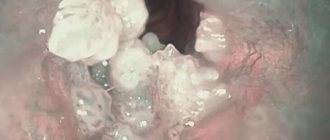Are warts dangerous during pregnancy?
About 90% of people around the world are already infected with HPV by default. But, like the causative agent of herpes, this virus can lie dormant for years. Therefore, the appearance of warts during pregnancy should not be taken as something extraordinary. But there is reason to wonder whether you are doing enough to strengthen your immune system.
Therefore, in the vast majority of cases, expectant mothers need not worry about this and postpone going to the dermatologist for the next 9 months. Exceptions include genital warts (condylomas). If they are located in the vagina or in the cervical area, then there is a real threat of infecting the baby with HPV during pregnancy or childbirth. In such cases, you will still have to consult a doctor. Also, do not put off solving the problem until later if the neoplasm looks atypical and more like a tumor.
Dermatologist reveals the truth about treating papillomas in pregnant women
Papillomas grew on the body.
For example, on the neck or armpit. It would seem, what’s so terrible? Just a few skin growths.
However, few people know that papillomas are symptoms of the human papillomavirus, or HPV for short. This is the name of a group of viruses consisting of more than 100 species.
HPV is widespread among the world's population. According to statistics, up to 80% of people of sexually active age become infected with the human papillomavirus at least once in their lives. It is transmitted through direct contact, often during sex. Even using condoms does not completely protect against infection.
Pregnant women are always wary and worried when it comes to viruses. And this is correct - the situation obliges you to play it safe and learn as much as possible about the disease.
However, it is too early to sound the alarm.
Most types of HPV cause discomfort only due to the appearance of the neoplasm itself. It looks ugly and constantly bumps into something. Moreover, they usually appear when the immune system is weakened. Not too pleasant, but not at all deadly. Many people live with papillomaviruses for years and do not suspect it.
Unfortunately, not all HPVs are equally harmless.
There are also dangerous exceptions. Highly oncogenic papillomaviruses lead to the formation of cancer cells. We are talking about HPV types 16, 18, 31, 33, 35, 39, 45, 51, 52, 56, 58, 59.
These viruses cause cancer of the cervix, genitals, anus and throat. Cancer cells grow slowly—sometimes decades pass before a person gets sick.
It is impossible to independently determine what type of HPV you have. For this purpose, laboratory tests are carried out.
Even if you find yourself with papilloma, do not panic. Perhaps we are talking about oncogenic HPV, perhaps about ordinary ones. Get tested and wait for the results. If you are unlucky and are diagnosed with the dangerous 16th or 18th type of papillomavirus, you will still have time to prevent the appearance of cancer. After all, now you know about the problem, and it will not be able to strike you on the sly.
Now there are many methods for removing papillomas. Laser treatment of tumors is especially popular.
But before you run to get rid of them, we advise you to get examined by a doctor. It is always useful to obtain specialist consent for surgery. In addition, it will help you find out how dangerous your tumors are.
But what if you are pregnant and want to be cured of HPV? Is it necessary to remove papilloma during pregnancy?
These questions concern many women who are preparing to become mothers.
Don’t worry, in the vast majority of cases, papillomaviruses do not affect the baby’s development in any way. Pregnant women with papillomas do not need special care.
However, if pregnant women develop papillomas, we recommend informing your gynecologist about this. He will decide whether you need to take additional tests to determine your HPV type.
Medical research shows no link between human papillomavirus and pregnancy complications. The likelihood of transmitting the virus to a child is very low.
As you can see, there is no particular need to remove papillomas in pregnant women.
Even if the patient has developed tumors of high oncogenic risk, the doctor usually postpones treatment until the baby is born.
During pregnancy, papillomas on the genitals sometimes bleed and increase in size due to hormonal imbalance. Sometimes fresh new growths appear next to them. If they can interfere with childbirth, the doctor removes them surgically.
It is easier to remove papillomas on other parts of the body during pregnancy. This procedure is not dangerous. But we recommend talking to your doctor first or waiting until the baby is born so as not to expose him to unnecessary stress.
Is it possible to remove warts during pregnancy on your own?
Many people are interested in whether it is possible to remove warts for pregnant women at home? Indeed, some folk remedies have proven themselves very well in solving this problem. But how they will affect the baby’s health is not known for certain. Therefore, in any case, it is impossible to do without prior consultation with a doctor. And if there are neoplasms in the intimate area, self-medication is strictly prohibited!
Types of warts
HPV is divided into several dozen types. They cause different types of warts:
- Anogenital warts are caused by HPV types 6 and 11. These warts are located around the anus and on the genital mucosa;
- Plantar warts resemble calluses and are caused by HPV types 1–4. They are very painful and often interfere with walking;
- Flat warts appear as flat nodules and are often located on the fingers or on the back of the hand. Most often, such warts form in children and young people, which is why they are also called juvenile warts. They are caused by HPV types 10, 28 and 40;
- vulgar (ordinary) warts are usually located on the hands, but can appear in other places. Such warts are painless and are small lumps with a diameter of 1–4 mm. They can merge into large plaques. Common warts are caused by HPV type 27.
In conclusion, we note that folk remedies for treating warts do not have proven effectiveness, and are sometimes downright dangerous.
To remove skin tumors, it is best to immediately contact a professional. July 1, 2021
Author of the article: dermatologist Mak Vladimir Fedorovich
Is it possible to remove warts with nitrogen during pregnancy?
Can pregnant women remove warts with nitrogen in a clinical setting? There are no strict contraindications in this regard, however, some nuances of such procedures should be taken into account. On the one hand, cryodestruction is the cheapest and, most importantly, painless method of removing ill-fated formations. However, not all skin growths can be gotten rid of with its help. Thus, plantar warts are destroyed most effectively when treated with liquid nitrogen. However, it is impossible to influence the mucous membranes of organs (in particular, the uterus) in this way.
In addition, the cryodestruction method involves several procedures. And given that anesthesia is contraindicated at any stage of pregnancy, this only creates additional stress for the expectant mother’s body.
Removing warts with liquid nitrogen
Today, warts can be removed using liquid nitrogen. This method of treatment is traditional and is called cryodestruction.
In simple terms, pathologically altered tissue is exposed to low temperature.
Cryodestruction is a modern method of treating superficial benign neoplasms, based on cooling tissues to extremely low temperatures and their subsequent destruction.
Cryodestruction of warts
The active substance used during treatment is liquid nitrogen. Possessing unique physical properties, it is capable of transforming from gas into liquid and back at very low temperatures (-196 °C).
There are no places on our planet where there would be such a temperature regime, so nitrogen in the air is in the form of gas. However, the use of special equipment makes it possible to reduce its temperature, making it liquid.
The procedure for removing warts with liquid nitrogen involves freezing the tumors, which leads to a slowdown in the growth of cells with a disrupted structure and the destruction of benign tissue growths.
Stages of cryodestruction
- Exposure to nitrogen.
Gauze or cotton wool is wrapped around a wooden stick - this is the tool with which the specialist removes liquid nitrogen from the container. The substance is then applied to the wart while the doctor presses lightly on it. Depending on the size of the papilloma, the exposure time is 5-30 seconds. For example, removing plantar warts with nitrogen will take more time, since all layers of the skin must be frozen to obtain the desired result.
- Pause.
After the specialist has “cauterized” the formation for the first time, the procedure is interrupted for 1-2 minutes. This is necessary to assess the effectiveness of the intervention. Usually, at the site of “cauterization,” the skin turns white, but after 2 minutes it thaws and the doctor can determine the depth and magnitude of the effect of nitrogen on the skin. Based on this, a decision is made whether to repeat the procedure or not.
- Result.
Skin that has been frozen takes on a whitish-pink hue. This indicates that skin cells have died.
- What's next.
If the removal of warts using nitrogen results in redness of the skin, then we can talk about a positive result. Almost always the next day, a bubble appears at the site of exposure (the size may vary). There is no need to worry about this - this is a common occurrence, as it should be.
Inside the bubble there will be a liquid - colorless or reddish. The color depends on the depth of exposure: when it reaches the deep layers in which the blood vessels are located, the liquid becomes reddish; if nitrogen affected only the surface layers, then it will be slightly white.
What can and cannot be done with a bubble after freezing with nitrogen?
- To avoid damaging the blister, do not place an adhesive plaster on it.
- It is possible to apply a gauze napkin, and to fix it, you can already use an adhesive plaster.
- You can take water procedures, but only carefully to prevent damage to the bladder.
- To protect the treated area, dressing with a piece of gauze is allowed.
- If the area affected by nitrogen is severely painful, taking painkillers (Analgin, Ketorol) is allowed.
If repeated treatment is necessary, and this happens often, moles or other formations are removed with liquid nitrogen 3 weeks after the first freezing. Usually after this the warts are completely removed.
Benefits of wart removal at the Miracle Doctor clinic
The clinic employs highly qualified and experienced dermatologists. Their high professionalism is confirmed by relevant certificates. All employees have access to sophisticated medical equipment and are certified specialists in the field of cryotherapy, cosmetology and other treatment methods.
Can pregnant women have warts removed with laser?
The question of whether it is possible to remove warts during pregnancy using a laser is the second most popular question. However, there is no clear answer to this either. Laser therapy is considered a more effective and reliable method of getting rid of most skin lesions. Significant advantages of this procedure are accelerated recovery after surgery, compared to cryodestruction, as well as a low likelihood of relapses and scar formation at the site of wart removal. The downside is that it takes a long time for the tissue to heal after the plantar growths are removed.
Methods for treating warts on fingers during pregnancy
The easiest way to solve the problem is with folk remedies that do not require prescriptions or a doctor’s prescription. However, the use of even the safest formulations must be supervised by appropriate specialists to avoid harm to health. You can go the other way - seek help from traditional medicine; it is also worth thinking about combining both of these options.
Folk remedies for warts on the finger during pregnancy
With this location of the growth, the most effective form of folk remedies for treating warts during pregnancy are baths. One of them can be made based on sea salt mixed in an amount of 2 tbsp. l. with warm water (10 l). After this, you need to shake it well with your hands and hold them there for about 15 minutes so that your fingers are completely immersed in the liquid. Such manipulations should be performed once a day at least every other day. On average, treatment can last 2 weeks.
Here are other remedies that may help solve the problem:
- Sea buckthorn oil . Heat it over low heat, preferably in a water bath, soak a cotton pad in it and gently wipe the formation without pressing too hard. After 10 minutes, wash your hands with clean water and wipe dry. To remove a wart during pregnancy, this procedure must be carried out at least 2 times a day.
- Wormwood decoction . To prepare it, mix this herb, previously dried, with water, adhering to the proportions of 2 tbsp. l. for 250 ml. After combining the components, keep the mixture on the stove for about 5 minutes, boil and cool. Next, soak cotton wool in it and treat the formations, thoroughly lubricating the entire surface. In order for treatment of warts during pregnancy to have the desired effect, it must be carried out for at least 10 days twice a day.
- Green tea . Pour 3 tbsp into a container. l. leaves of the bush of this plant and pour boiling water (300 ml) on top. Then cover the ingredients and let them sit for about 40 minutes. After this time, use a sieve to drain the liquid and treat problem areas with cotton wool three times a day until the problem is eliminated. On average, treatment of warts on the fingers during pregnancy takes from 7 to 15 days.
- Vinegar . It is best if it is apple or rice, that is, natural. Pour it into a deep container, place a piece of gauze in it and soak it well with the product. Next, wipe the disturbing areas and leave the napkin here for 10 minutes. Then remove and wash your hands or feet with soap and then dry your skin.
- Aloe . Cut a leaf from a young plant, wipe it with a clean cloth and cut. At this point, press down on it and squeeze out as much juice as possible. They should treat warts on the fingers during pregnancy, treating them 3 times a day for 2 weeks.
- Celandine . It is best to buy ready-made juice of this plant and use it to carry out external treatment of the desired areas. It is recommended to do this 3 times a day until the formations completely disappear. On average, such treatment lasts from 10 to 15 days, depending on the individual characteristics of the body.
In the fight against warts on a pregnant woman's finger, rubbing them with laundry soap moistened with water, treating them with essential eucalyptus and castor oils, and lubricating them with potato, lemon, garlic and onion juice helps a lot. The optimal frequency of such treatments is from 2 to 5 times a day, and the more often this is done, the faster results will be obtained.
No less effective in treating warts on the fingers during pregnancy is a mixture of alcohol and crushed green walnut peel, taken in a 1:2 ratio. After mixing the components, the composition is left covered for 3 weeks. Then it is filtered and the resulting liquid is used twice a day to treat the growths until they die.
How else can you remove warts in pregnant women?
Methods that have proven themselves in removing skin lesions in pregnant women also include radio wave therapy and electrocoagulation .
The first is a targeted effect on the wart with a so-called radio knife. As a result, it is destroyed while maintaining the integrity of healthy tissue. The likelihood of relapse is negligible. A significant disadvantage is the risk of scar formation after removal of a large tumor. Therefore, the radio wave method is usually used to get rid of papillomas, which have a characteristic thread-like base.
The second one works on a similar principle. The only difference is that the excision of the wart is carried out with an electric scalpel, which literally evaporates it to the very root. In this case, the microvessels are welded together without causing bleeding. Electrocoagulation not only removes the wart, but also reduces to zero the likelihood of its reappearance or further growth. And when getting rid of benign tumors, it does not allow them to turn into a malignant form.
Recently, in Russia there has been an increase in the incidence of cervical cancer (CC) in young women of reproductive age, especially in the group of women under 29 years of age. As a cause of death in women under 30 years of age, cervical cancer accounts for 8.5% [4]. Among oncological diseases in pregnant women, it is 45%. According to S.I. Rogovskaya [10], among 1000 pregnant women, severe dysplasia and cancer in situ
, in 0.45 cases - invasive cervical cancer.
The main etiological factor of cervical cancer is the human papillomavirus (HPV), which was confirmed by the results of both epidemiological and molecular biological studies [2, 5, 8, 11, 14]. HPV is also the cause of dystrophic and malignant diseases of the vulva and vagina in women and the penis in men [6]. The likelihood of spontaneous elimination of HPV during carriage and the possibility of spontaneous regression of both subclinical and clinical forms of human papillomavirus infection (PVI) inclines a number of researchers to observational tactics [1, 3, 12]. However, HPV is not considered a normal representative of the vaginal biotope [7, 9].
Currently, there is no consensus on the effect of HPV on the course and outcome of pregnancy. It is known that pregnancy is a risk factor for the development of PVI and promotes active replication and persistence of the human papillomavirus. Research by A. Schneider et al. (1987) showed that the incidence of PVI in pregnant women is 2.3 times higher than that in non-pregnant women, while the amount of viral DNA in pregnant women is on average 10 times greater than the same amount in non-pregnant women. The number of cases of HPV transmission from mother to fetus, according to various researchers, ranges from 4 to 87%, which depends on the sensitivity of the diagnostic methods used [10, 13].
There is evidence that HPV infection of the genitals leads to an increase in spontaneous abortions, while HPV DNA is found in syncytiotrophoblast cells [12]. How the virus is transmitted from mother to fetus is unclear. Bloodborne transmission is unlikely because HPV is only occasionally found in white blood cells. Ascending HPV infection of the amniotic fluid and placenta is most likely. There are alarming reports about the detection of HPV in the amniotic fluid of pregnant women, about an increase in the frequency of papillomavirus lesions of the larynx and bronchi in children, which indicates their infection during pregnancy. Thus, HPV DNA is detected in 33% of newborns in nasopharyngeal aspirate, as well as in the amniotic fluid of HPV-positive women [13, 15]. Transmission is also possible through direct contact (skin contact), as well as during childbirth - infection of a newborn from an infected mother. The third possible route is infection during conception through sperm.
Respiratory tract papillomatosis, most often caused by HPV types 6 and 11, has a severe course in young children with a tendency to recur. In 75-87% of cases, signs of juvenile respiratory papillomatosis are recorded in the first 5 years of life, which is probably due to the functional immaturity of the immune system [16].
Features of the course of PVI during pregnancy.
Estrogens and progesterone increase HPV expression in the cervical epithelium and promote cellular proliferation and carcinogenesis, and during pregnancy there is an extremely high release of sex hormones. Due to increased vascularization, active metabolism in tissues, changes in vaginal microbiocenosis, and a decrease in the compensatory capabilities of the immune system, the risk of infection and the incidence of various infections increase. In this case, latent PVI can develop into sub- and clinical forms [10].
Pregnancy may be a risk factor for the development of PVI and contribute to active replication and persistence of HPV. During pregnancy, visible condylomas often recur, tend to grow, become loose, and can reach gigantic sizes.
Prevalence of PVI among pregnant women.
At the Moscow Regional Research Institute of Obstetrics and Gynecology, a survey of 700 consecutive pregnant women admitted to a specialized appointment for cervical diseases was carried out in order to identify PVI. During a screening examination of these pregnant women using the polymerase chain reaction method, clinical and laboratory manifestations of PVI were identified in 46 (67%) pregnant women.
The results of a survey of pregnant women with various diseases of the cervix showed that PVI is more often found in patients with cervical intraepithelial neoplasia (CIN) (95.5%), in pregnant women with complicated ectopia (32.4%), with leukoplakia (56%), after surgical treatment of CIN (42%), with polyps of the cervical canal (38.8%). It should be noted that even with an unchanged cervix, HPV was detected in every third pregnant woman (34%). Cytological signs of papillomavirus lesions of the cervix were observed in 12% of pregnant women with an unchanged cervix only in the second and third trimesters of pregnancy. In pregnant women with complicated ectopia, koilocytosis in combination with dyskeratosis of the stratified squamous epithelium of the cervix was detected in the first trimester in 7.4%, in the second trimester in 25.9% and in the third trimester in 31.5%. In pregnant women with cervical canal polyps, cytological signs of papillomavirus lesions of the cervix were detected in 20.8% of cases.
Despite surgical treatment of CIN at the preconception stage and follow-up of these patients, the number of cases of relapse of CIN during pregnancy was 4% against the background of PVI (presence of koilocytes).
In pregnant women with cervical leukoplakia, koilocytes were detected during cytological examination in 56% of cases. Most often, signs of papillomavirus lesions of the cervix were found in pregnant women with diagnosed CIN - in 73.3 and 77.7% of cases in the first and second trimesters, respectively.
The presented data once again confirms that the cytological research method currently remains the leading one in the diagnosis of cervical diseases. Unfortunately, there is still a misconception among gynecologists about the dangers of in-depth cytological examination of the cervix in pregnant women due to possible complications. At the same time, the high incidence of cervical diseases during pregnancy dictates the need for mandatory cytological examination of the ecto- and endocervix in pregnant women when registering them.
Genital condylomas of the vulva and vagina were identified during colposcopic examination in 62% of pregnant women. They were irregularly shaped fibroepithelial formations rising above the surface of the mucous membrane with finger-like or cone-shaped protrusions on a thin stalk, less often on a broad base in the form of a single nodule or in the form of multiple outgrowths resembling cauliflower or cockscombs. The surface of condylomas was covered with stratified squamous epithelium and often keratinized. Vessels were located in the underlying stroma. In some cases, inflammatory reactions, microcirculation disorders and edema occurring in the stroma contributed to the addition of a secondary infection. In 5.3% of pregnant women, cervical condylomas were detected in the form of a tumor with kidney-shaped papillae, evenly distributed over its surface and forming a repeating pattern. 9% of pregnant women had giant condylomas of the external genitalia and vagina, up to 7 cm in size.
State of local immunity.
The presence of benign cervical diseases and PVI was accompanied by a sharp decrease in local immunity, most pronounced in pregnant women with CIN. It was manifested by a decrease in the production of secretory immunoglobulin A (sIgA), which is the main indicator of immune defense, and an increase in the production of immunoglobulins A, M and G (IgA, M, G). The most pronounced changes in the content of immunoglobulins of all isotypes were observed in pregnant women with CIN. They were characterized by extremely low production of sIgA (2.2±0.5 μg/ml) and high level of IgM (24.8±0.9 μg/ml), which is considered as a marker of inflammation. The average IgA levels were 24.2±1.6 μg/ml, IgG - 1248.6±46.5 μg/ml. In healthy pregnant women, the level of sIgA was 12.2±0.5 µg/ml, IgA - 36.5±0.5 µg/ml, IgM - 2.6±0.5 µg/ml, IgG - 456.5±35 .5 µg/ml.
The results obtained confirm the connection between cervical diseases and impaired local immunity, which is of great importance for the selection of adequate immunocorrective therapy, and indicate that the degree of local immunity impairment is directly proportional to the severity of cervical disease.
Algorithm for managing pregnant women with PVI
Stage I - examination
— Diagnosis and treatment of other genital infections and vaginal dysbiosis.
— Extended colposcopy.
— Detection of HPV DNA with typing.
— Cytological examination (PAP test).
Stage II - determination of tactics
— Indications for observation: latent form of PVI, vestibular papillomatosis.
— Indications for treatment: genital warts of the vulva, vagina, cervix.
— The management tactics for pregnant women with CIN I should be watchful and expectant with dynamic colposcopic observation and cytological control, with final treatment of the cervix after childbirth.
— If there are signs of PVI and CIN I-III, anti-inflammatory treatment and correction of vaginal microbiocenosis are carried out, after which it is necessary to repeat the PAP test.
— If after treatment there are signs of PVI, CIN II-III in pregnant women, or if the results of colposcopic or cytological examination worsen, a cervical biopsy with histological examination and consultation with an oncologist are indicated.
— If CIN III is detected, a mandatory consultation with an oncologist is necessary; if CIN III is detected in the II-III trimesters, it is possible to prolong pregnancy with dynamic cytological and colposcopic monitoring once every 3 weeks, followed by treatment after delivery.
- Indications for cervical biopsy during pregnancy are atypical cytological and colposcopic patterns suspicious for cancer (heterogeneous surface, exophyte, erosion or ulceration and atypical vascularization).
Stage III - comprehensive examination and determination of management tactics in the postpartum period
based on colposcopy data, cytohistological re-evaluation of previous data.
Treatment of diseases associated with HPV during pregnancy must be carried out differentiated according to indications at any time, but preferably in the first trimester [10]. Before using destructive methods of treatment, it is recommended to conduct a comprehensive examination and treatment of concomitant inflammatory diseases of the genitals.
The methods of choice for the treatment of genital warts in pregnant women are radio wave therapy and the use of chemical coagulants - solcoderm, trichloroacetic acid. It is possible to use laser therapy, electrocoagulation, and surgical methods.
The radio wave method is the most acceptable from the point of view of gynecological oncology, since all removed material is available for histological examination. This fundamentally distinguishes it from laser and cryodestruction, in which the material is completely absent, and from electric knife treatment, in which tissue charring occurs. Removal of large genital warts of the vulva, vagina and cervix is carried out under local anesthesia using the radiosurgical method (“Surgitron”) using a radio loop in the “cut and coagulation” mode (power 2-4 units), the use of high-frequency waves (3.8 MHz) provides more gentle tissue incision and allows you to remove exophytic formations bloodlessly, painlessly, without traumatizing surrounding tissues and obtaining complete material for histological examination.
Due to the risk of adverse effects on the fetus during pregnancy, the use of cytostatic drugs is contraindicated, which, having antiproliferative activity, promote cell destruction, affecting both damaged and healthy cells.
A mandatory method of treating PVI in pregnant women is immunocorrective therapy. The use of interferons (IFNs) and their inducers is promising. IFNs are endogenous cytokines that have antiviral, antiproliferative and immunomodulatory properties. There is evidence of differences in the immune response during infection with high- and low-oncogenic types of HPV. In the presence of HPV types 16–18, there is a decrease in the production of α- and γ-IFN, an increase in the concentration of serum IFN, spontaneous production of IFN, leading to an imbalance in cellular immunity and, as a consequence, to a severe course of the disease.
During pregnancy, intravaginal, rectal and external agents, and systemic drugs are used. Interferon therapy is carried out from the second half of pregnancy. Viferon is the optimal drug for immunocorrection during pregnancy. It contains recombinant α2-interferon, as well as membrane-stabilizing components - α-tocopherol acetate and ascorbic acid. Viferon is an immunomodulator that affects the processes of differentiation, recruitment, functional activity of effector cells of the immune system, as well as the efficiency of immune recognition of antigen and increased phagocytic and cytolytic activity. To exclude the development of phenomena of refractoriness of effector cells to the action of IFN, systemic administration of the drug should be intermittent. In addition, the protective effectiveness of IFN has been proven in diseases caused by intracellular parasitic microorganisms (chlamydia, mycoplasma, etc.). Obviously, the effect in this case is also associated with the suppression of protein synthesis and activation of phagocytosis.
Viferon is available in the form of suppositories 150,000 IU, 500,000 IU, 1,000,000 IU and 3,000,000 IU for rectal use. Pregnant women are usually prescribed suppositories of 150,000 or 500,000 IU 2 times a day for 10 days. When using Viferon, a high concentration of interferon is created at the site of infection, which promotes rapid relief of subjective symptoms, reducing doses and duration of antibiotic therapy. The use of Viferon in the complex treatment of STIs in pregnant women has a positive effect on the immune system and increases the effectiveness of antimicrobial therapy.
Patients with PVI often experience a disturbance in the vaginal microbiocenosis - a sharp deficiency of lactobacilli, an excess of opportunistic microflora. There is a significant contamination with yeast-like fungi. In a large percentage of cases, there is infection with sexually transmitted microorganisms - chlamydia, genital mycoplasmas, etc. In the presence of a urogenital infection, antibiotic therapy is carried out after 12 weeks of gestation. Correction of vaginal microbiocenosis in pregnant women is carried out using local approved drugs. During pregnancy, therapy with glycyrrhizic acid, which has antiviral activity, is possible. Correction of vaginal microbiocenosis with the help of eubiotics is also necessary.
The issue of delivery in women with PVI is decided individually. Studies have shown that abdominal delivery does not reduce the risk of fetal infection (N. Sedlacek, S. Lindheim et al., 1989); cases of children born by cesarean section with laryngeal papillomatosis have been described.
Due to the high frequency of PVI in pregnant women and the participation of HPV in the processes of carcinogenesis, it is necessary to optimize the preconception preparation of women, including a comprehensive examination to identify HPV, carry out its typing, as well as treatment of HPV-associated diseases at the stage of pregnancy planning.
When planning pregnancy, subclinical forms of infection, as well as CIN, must be treated before pregnancy.
Carriage of HPV is not a contraindication to pregnancy.
It is not possible to completely cure a woman of virus carriage, therefore adequate preconception preparation is a sufficient measure to prevent exacerbation of PVI during pregnancy.
Safe removal of warts and papillomas at the Stoletnik MC
We have sorted out the question of whether it is possible to remove warts during pregnancy. If you are looking for where you can do this in Penza, we invite you to the medical office at the address: st. Chaadaeva, 95.
Highly qualified specialists and modern equipment are at your service. The procedure for excision of warts is performed surgically or by electrocoagulation. The extensive experience of our doctors and an individual approach to each patient guarantee a positive result when removing tumors of any complexity, without risks to the health of the mother and baby.
Make an appointment and consultation by phone: +7 (8412) 999-395, 76-44-20.
Literature
- Adler J. What the skin hides. 2 square meters that dictate how we live. – M.: Bombora, 2022. – 352 p.
- Gomberg M. A., Soloviev A. M. Treatment of warts and genital warts is simple and effective // Medical Council. − 2011.− No. 5. − P. 60−65.
- Molochkov A.V., Khlebnikova A.N., Lavrov D.V., Gureeva M.A. Genital papillomavirus infection. Tutorial. − 2010. − 10 p.
- Rogovskaya S.I. Human papillomavirus infection in women and cervical pathology. − M.: GEOTAR-Media, 2005. − P. 15–17.
- Yunusova E. I., Yusupova L. A., Mavlyutova G. I., Garayeva Z. Sh. Flat warts: features and treatment options // Attending physician (electronic edition). − 2016.− No. 5.








